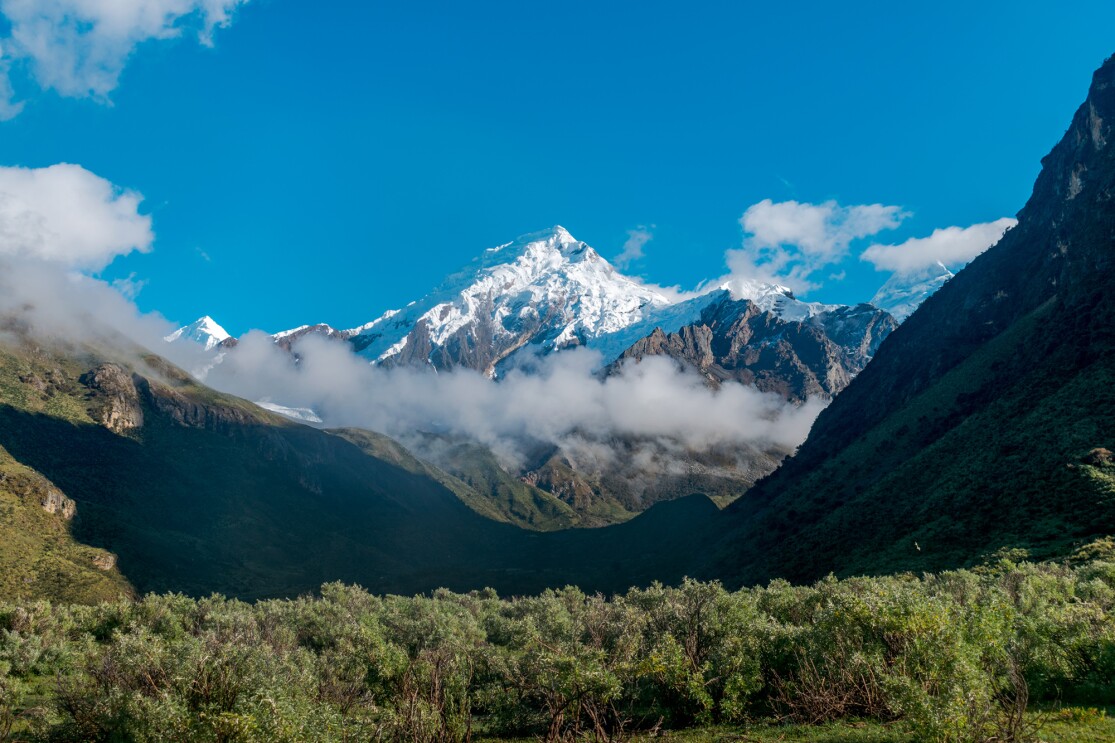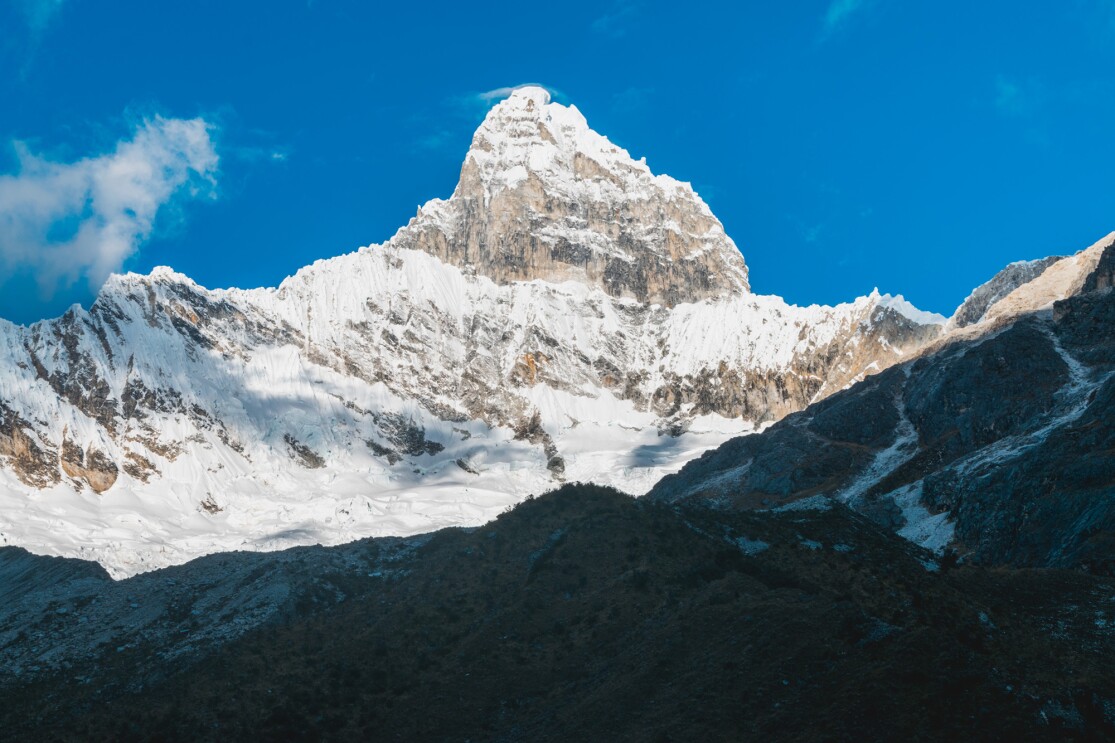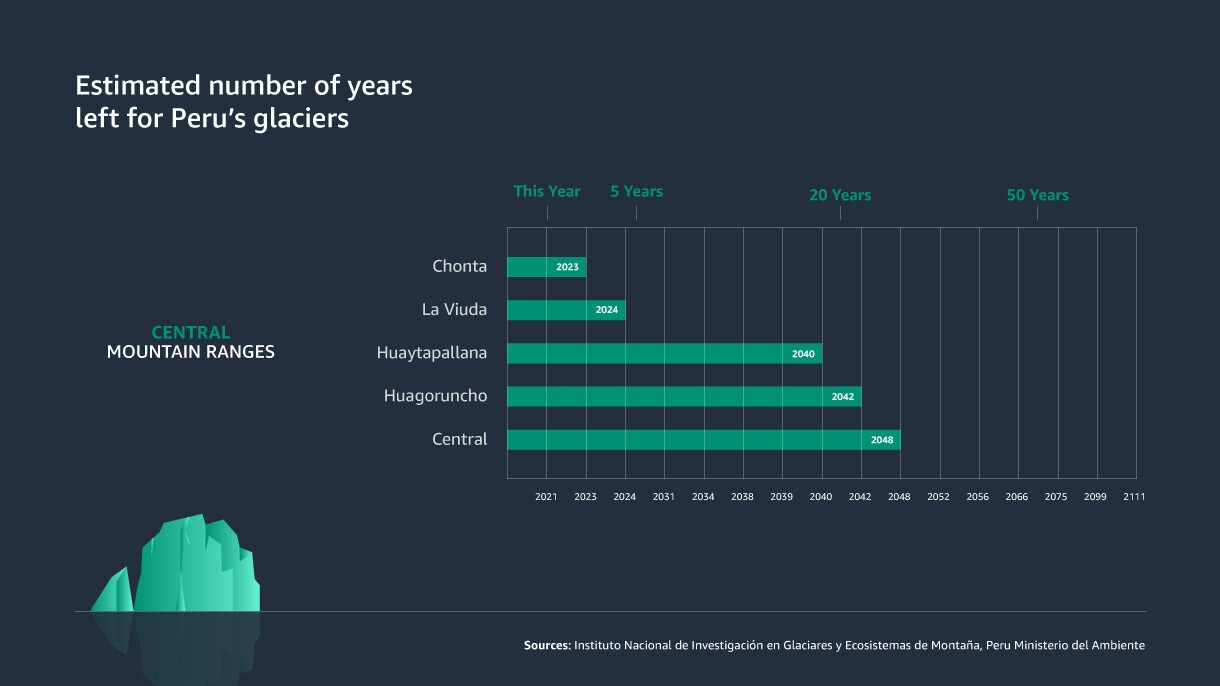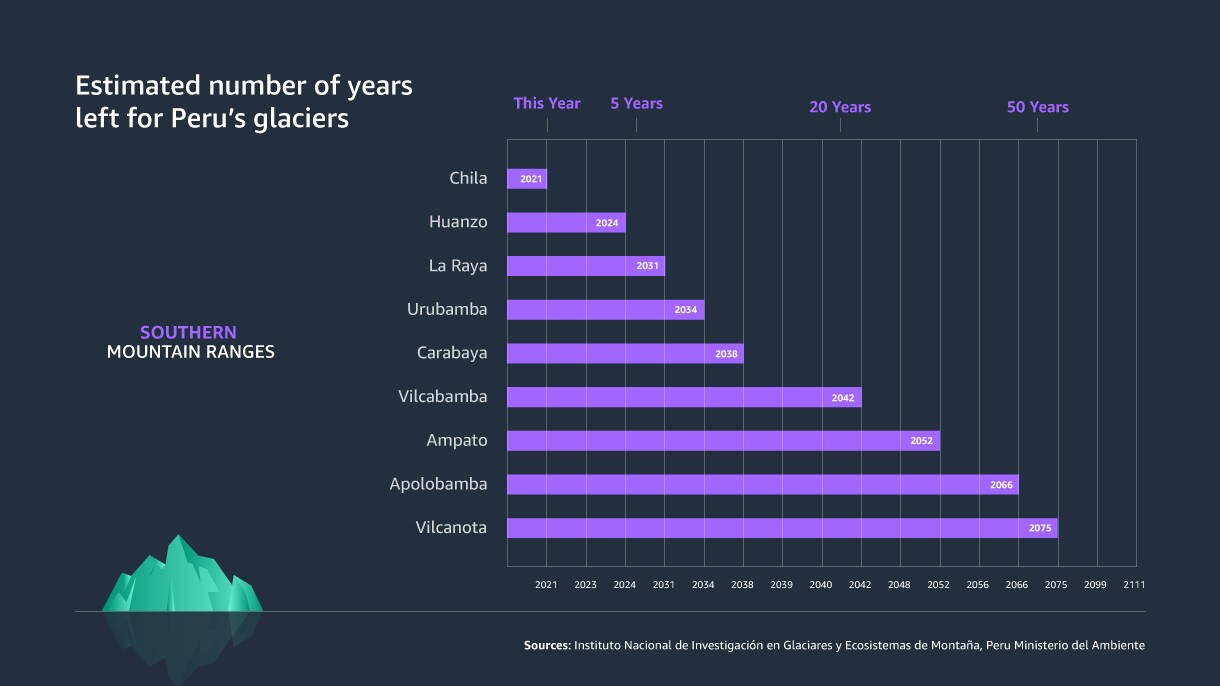Using satellite imagery from high above and sensors on the ground, scientists are studying glacier recession across the Andes in Peru. The glaciers are simply melting away in a warming climate, affecting not only the environment, but also cultural and economic issues across the region.
Researchers built models with the help of Amazon Web Services (AWS) to monitor and track the 18 cordilleras (mountain ranges) with glacial mass in the Peruvian section of the Andes, the mountain range that spans western South America. Here’s what researchers have found and predicted so far:
The takeaway
Within 20 years, half of Peruvian glacier bodies on cordilleras are projected to disappear, according to the latest data. By the end of this century, only two cordilleras with glacial mass are predicted to remain in the stretch of the Andes that runs through Peru.
Researchers gather the data via sensors on the ground in the Andes, plus satellite imagery. The information is analyzed by climate scientists from Peru’s National Institute of Research on Glaciers and Mountain Ecosystems, or the Instituto Nacional de Investigación en Glaciares y Ecosistemas de Montaña (INAIGEM), in partnership with the Ministerio de Ambiente, Peru’s Ministry of Environment and Sustainable Development.
Together, the researchers built models using AWS to research the glacial recession. The same sensors and data gathering infrastructure will also help Peruvian agencies pinpoint and predict landslides, mudslides, flooding, and other effects from the melting glaciers.
The environmental impact
The melting glaciers of Peru are a harbinger of what is to come for other parts of South America and the Amazon region, said Dr. Christian Yarlequé, a physicist and atmospheric scientist who took part in the study. Yarlequé is also the deputy director of information and analysis, the Subdirector de Información y Análisis, at INAIGEM.
“What happens to the Amazon is due to the warming conditions in Peru,” Yarlequé said. “The change will be felt beyond Peru as temperatures rise in the valleys of the Andes, and wind and precipitation patterns change because of the warming climate.”
The impacts of climate change in Peru are being seen first in the Andes region, which has warmed more rapidly than coastal regions in the country that are tempered by the Pacific Ocean, Yarlequé said.
“The means temperature rise is greater in the Andes, which is a more sensitive ecosystem and behaves in different ways. But what happens there can teach us a lot about what will occur in similar regions, and what the impacts will be in less sensitive places as they warm.”
 Quillcayhuanca, Cordillera Blanca, northern Peru
Quillcayhuanca, Cordillera Blanca, northern PeruThe economic cost
Tourism is a main driver of the Peruvian economy, and many people travel to Peru to see the glaciers. Even amid the pandemic, tourists have been eager to see Peru’s glaciers before they’re gone.
For the Andean towns that rely on tourism, and whose glaciers are melting fastest, tourism will need to shift. If the industry doesn’t adjust, it may also disappear.
“The landscape will change, and you would expect that will mean lower levels of tourism, simply because the views that people travel to these places for will change,” Yarlequé said. “Some places will be overrun by tourists, and others will have virtually none.”
The scientific cost
As with other glaciers around the world, the ice within Peru’s glaciers contains a record of the climate dating back thousands of years. The melting means that physical record of the past is also disappearing.
“The glaciers contain evidence of past climates as far back as 10,000 years ago,” Yarlequé said. “Just like the tourists eager to see the glaciers before they go, scientists are very eager to gather what data they can while the glaciers are still intact so they can use the data to help to validate their models and theories about past climate periods in the region, and across the planet.
“We know this data will disappear soon, and scientists want to save it before it’s gone.”
 Artesonraju, Cordillera Blanca, northern Peru (also featured in hero image)
Artesonraju, Cordillera Blanca, northern Peru (also featured in hero image)The impact on culture
Since Pre-Incan times, more than 15,000 years ago, people have lived on the slopes of the Andes in Peru, adapting over the centuries to the shifts in climate and temperature.
“If we look at the Incas, they really understand how to live in the Andes through El Niño (wet) and dry seasons, they understand the climate and have their own mitigation plans and actions,” Yarlequé said. “They move up and down the mountains to respond to changes in climate conditions, to plant and to tend their animals, depending on precipitation or whether they needed to access the water stored in the glaciers.”
But people moving up and down the mountains to account for shifting seasons and wet and dry years—migration patterns that have worked for centuries—rely on glaciers existing in some form. Without the glaciers, the warming temperatures are threatening to make those well-worn plans obsolete. Already, more and more people are being forced out of their typical and traditional routines, and moving to higher elevations in the Andes.
01 / 04
“They need to plant their crops higher and higher, the potatoes and sweet potatoes, and they are bringing their animals to graze in higher elevations as well,” Yarlequé said. “But what happens when they can’t go any higher? What happens when there are no more glaciers for water?”
Yarlequé said he fears that the Incan technologies, crops, and processes won’t adapt well to the new landscape. But he points out that the Incas—for thousands of years—have always figured out a way.
“The Andean Peruvians, the Incas, are genius at solving problems not only related to climate, but social kinds of problems, and just the day-to-day things,” Yarlequé said. “But all of this is changing now in Peru, because the glaciers are melting. They need to find new crops; the same potatoes won’t grow. They need new sources of production and income. So it’s not just climate change, it’s a cultural change caused by climate change, too.”
Trending news and stories
- Amazon's Thank My Driver feature: How it works and how you can show appreciation all year long
- Everything you need to know about ‘Thursday Night Football’ on Prime Video
- What is Amazon Luna? Cloud gaming reimagined
- How Amazon is using predictive meteorology to help employees and partners stay safe this winter














